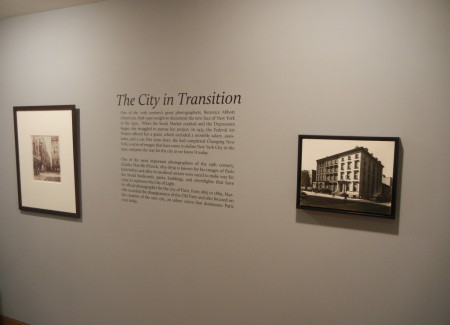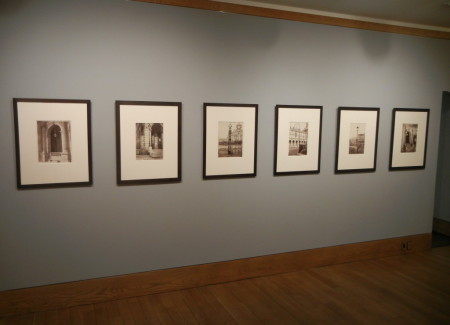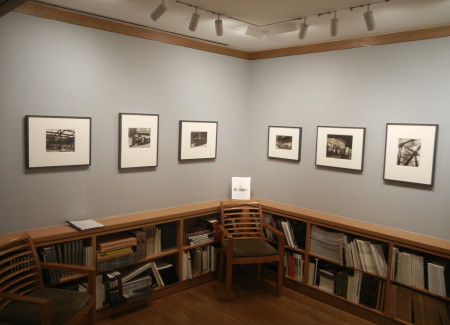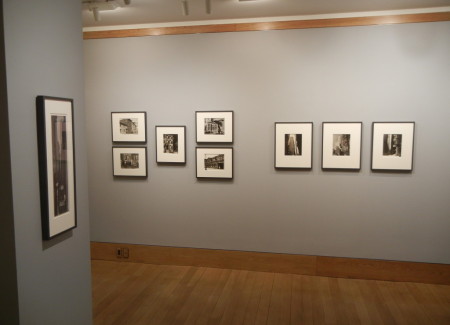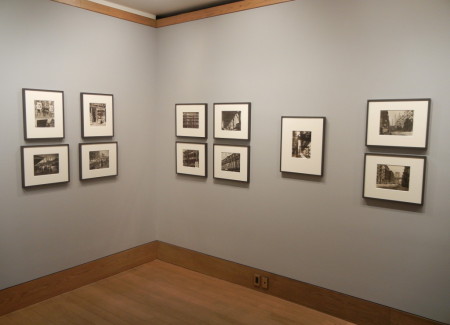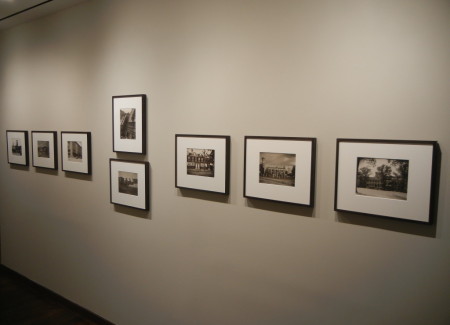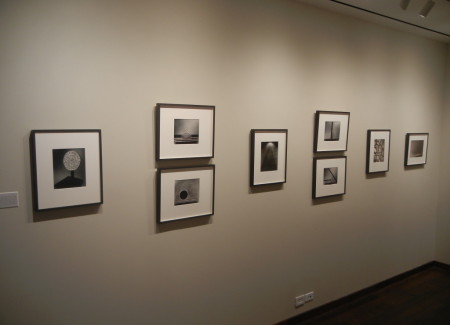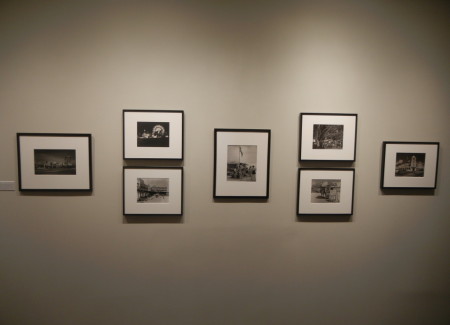JTF (just the facts): A paired exhibit of the black and white photographs of Berenice Abbott and Charles Marville, with prints generally framed in black and matted and hung against light grey walls in the main gallery space and the book alcove. The show includes 44 works by Abbott and 10 works by Marville. For Abbott, there are 43 vintage gelatin silver prints, sized roughly 3×4 to 20×16 or reverse (with most 9×7 or reverse), made between 1930 and the 1940s, and 1 photogravure, sized roughly 13×10, made 1932/printed later. For Marville, there are 10 albumen prints from wet collodion negatives, sized roughly 12×11 to 14×11 (or reverse), made between 1865-1869. An additional exhibit of Abbott’s work is also on view in the l-shaped second gallery space. This show includes 36 gelatin silver prints (mostly vintage) and 1 portfolio of 11 palladium prints, sized roughly 8×7 to 36×28 (or reverse), made between 1926 and 1961. A small supporting exhibit of the work of Eugène Atget can be found in the back gallery. It includes 7 prints: 2 gold chloride printing out paper prints, 4 albumen prints, and 1 gelatin silver print, all sized roughly 9×7 or reverse, made between 1885 and 1927. (Installation shots of the primary and secondary exhibits below.)
Comments/Context: This exhibit exists at the confluence of two events: the Charles Marville retrospective now on view at the Met and the recent transfer of the representation of the Berenice Abbott estate to the gallery. The result is a show that ostensibly pairs the two artists, leveraging the parallel theme of photographers documenting changing cities (Paris and New York respectively). But in reality, aside from a handful of Marville lampposts and street views, it’s really a mini Abbott retrospective, with works from New York in the 1930s in the main gallery and images from other parts of her career in the second space.
Given its status as one of the landmarks of photography, Abbott’s Changing New York project has already been thoroughly investigated by scholars and collectors alike, but this show is proof that there are still plenty of vintage gems buried in the estate. Two larger prints mounted on board (Fifth Avenue nos. 4, 6, 8 and City Arabesque) have a lush warm tone and a physical object quality that makes them stand out from the rest of the exhibition. Other classics like the hanging gunsmith sign, the narrow sliver of Exchange Place, the spiral ironwork of the Murray Hill Hotel, and the arched girders of the Riverside Drive viaduct are interspersed like old friends, mixed in with lesser known images of storefronts, landmarks, and the underside of the El. The criss-crossed girders from the construction of Rockefeller Center in 1932 are particularly bold and graphic, as are the geometric towers of the George Washington Bridge. Images taken from the tops of tall buildings (looking down) are matched with images of buildings from street level (looking up), balancing wider city vistas with up close grandeur. Front stoops, doorways, the alignment of windows, and the patterns of fire escapes are all viewed with attention to precise architectural detail, while the vernacular signage of a barber shop or theater brings a burst of chaotic life to the hardness of the city.
The second gallery is a whirlwind tour of Abbott’s other work, starting with her 1920s portraits made in Paris (Joyce, Cocteau, and others) and ending with her excellent scientific photographs made at MIT in the late 1950s. In between are more New York views taken over the years (the angular blackness of the Fulton Market, the all-over busyness of newsstands and cheese shop windows, the ghostly hanging deer), as well as road trip images of 1950s Florida beaches and hotels and the construction of the Norris Dam in Tennessee. While these pictures are loosely grouped, any one series might have deserved a fuller investigation, so this second supporting exhibit is a bit more of a sampler than a careful chronological tracing of her artistic history.
While this exhibit is going in a bunch of different directions at once and doesn’t set up much of a compare/contrast with Marville, it’s hard not to be inspired by the clarity and consistency of Abbott’s vision. Exhibits like this one remind us of both the elegance and visual inventiveness that she applied to this city, as well as the breadth and excellence to be found in Abbott’s long and often overlooked career.
Collector’s POV: The works in these shows are priced as follows. The Marville prints range from $20000 to $35000. The Abbott prints in the main show range from $10000 to $35000, with the photogravure at $1500. The Abbott works in the second show range from $7000 to $35000, with the palladium portfolio priced at $20000. The Atget prints range from $15000 to $65000.
Marville’s prints are intermittently available in the secondary markets, but very few of his best prints have come up for public sale in recent years. Individual prints have generally ranged between $1000 to $21000. Abbott’s work on the other hand is nearly ubiquitous at auction, with dozens of prints (a mix of vintage and later) coming up for sale in any given year. Prices have typically ranged from as low as $1000 to nearly $90000.
